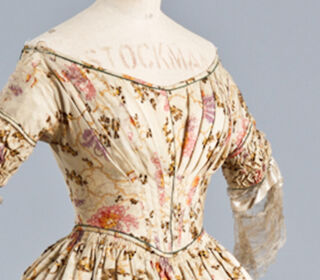
Blog

When Louise Chapman, our lecturer, circulated an email to our course looking for student volunteers to work with her on the upcoming ‘Cabinets of Costume’ exhibition I didn’t hesitate…The opportunity to get my hands on a real historic dress – when do you get to do that!
Louise’s email said the exhibition would be combining fashion and theatre design against a historical and contemporary context. It would form part of a larger international conference ‘Culture, Costume and Dress’ that the University is hosting later this month.
She was looking for 10 students to develop reproductions of five dresses from the School of Art’s archive to give the audience an overview of the collection held here at BCU.
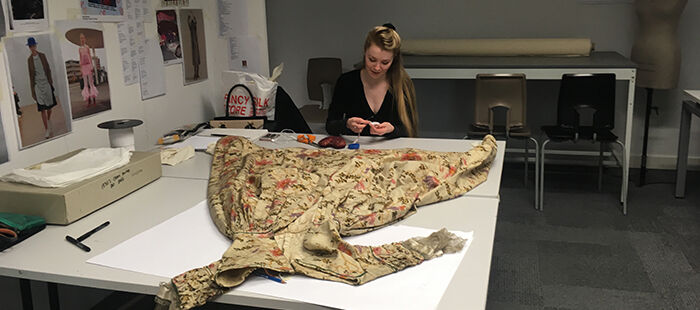 Even though Louise was quick to tell us that the project would be a big commitment to juggle around our course work and that we’d have to dedicate a lot of serious hours to it, there was no way I could turn such a great opportunity down so I volunteered straight away.
Even though Louise was quick to tell us that the project would be a big commitment to juggle around our course work and that we’d have to dedicate a lot of serious hours to it, there was no way I could turn such a great opportunity down so I volunteered straight away.
Since being at university, I’ve really learned to just go for things. It’s the best way to make sure you don’t look back and feel you missed out – and my confidence is growing so much since the beginning of my first year.
So on the first day of the project, Louise gave us an overview and then we got into pairs. She laid out the five dresses from the archive (from the Regency to Victorian eras) and asked us to pick out which one we’d like to reproduce. Naturally each pair seemed to gravitate towards a different dress.
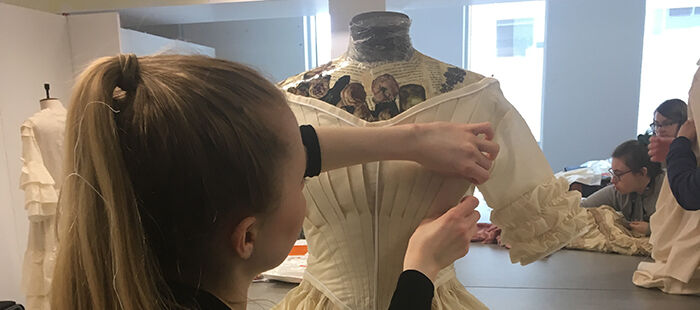 My partner was Sumeya and we picked the 1845 Honeysuckle dress. It’s a figured silk dress with a really high quality print. We chose it because we loved the design!
My partner was Sumeya and we picked the 1845 Honeysuckle dress. It’s a figured silk dress with a really high quality print. We chose it because we loved the design!
At first we couldn’t believe we were going to be working on the project and handling such incredible dresses from the archive!
“Are we actually allowed to touch them?”
It was strange handling them. They had an unusual smell. I still don’t think it’s sunk in properly that somebody wore it over 100 years ago!
Another reason we picked the Honeysuckle dress was because it didn’t look overly complex, but would still definitely have its challenges for us. It would give us an opportunity to learn, but was also achievable!
Sumeya and I brought different skills to our pair – I’m a maker and Sumeya is a pattern cutter. As a maker it was so interesting to see how they made the original Honeysuckle dress and the different techniques they’d used. It was definitely my favourite dress, I loved the sleeves and how they’d made them.
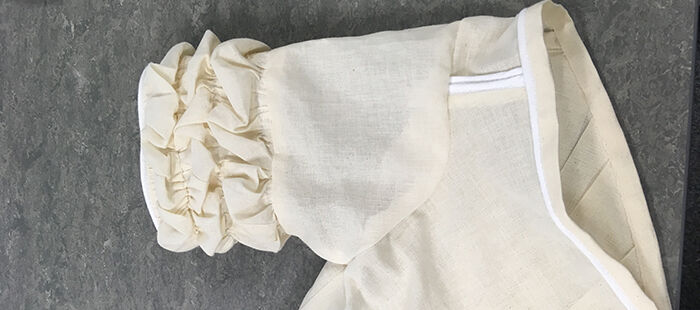 So to reproduce the dress, our brief from Louise was to forget our contemporary pattern making knowledge. She told us to instead rely on our eyes, creative skills and tacit knowledge to study the garment and visually unpick it to reconstruct a ‘ghost’ of the dress to be featured in the exhibition. She wanted us to consider at all the times the historical integrity of the dress and retain the authenticity. Her intention is to make the exhibition an ethereal experience, like stepping back in time.
So to reproduce the dress, our brief from Louise was to forget our contemporary pattern making knowledge. She told us to instead rely on our eyes, creative skills and tacit knowledge to study the garment and visually unpick it to reconstruct a ‘ghost’ of the dress to be featured in the exhibition. She wanted us to consider at all the times the historical integrity of the dress and retain the authenticity. Her intention is to make the exhibition an ethereal experience, like stepping back in time.
When it came to starting the work, Louise’s biggest piece of advice was to MEASURE EVERYTHING! So that’s where we started…
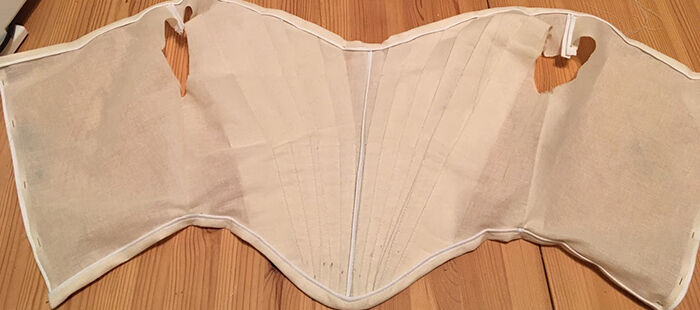 I can’t express how intricate this part of the process was. We measured every single aspect of the dress. Right down to every single pleat. Even where one pleat measured slightly wider than another (due to slight imperfections in the original making process all those years ago) we had to replicate it to the exact same detail!
I can’t express how intricate this part of the process was. We measured every single aspect of the dress. Right down to every single pleat. Even where one pleat measured slightly wider than another (due to slight imperfections in the original making process all those years ago) we had to replicate it to the exact same detail!
Once we had our measurements we then planned out our weeks to keep us on track to complete the finished garment in time.
So we began to make the toile (a toile is a version of the design made of cheaper fabric so that you can perfect your design before you make the final garment from the more expensive fabric). The first thing I did was to cut out the sleeves, then stitch them together, then gather them. At the same time Sumeya cut out the bodice and pleated it. Then I cut out the skirt and pleated that. We then went back to the bodice a little, as we were learning as we went along and working on the toile really helps you understand the making process as you go. Next was the finishing – sewing on the piping, binding and bottom of the skirt.
Louise checked all of our toiles before we began the final pieces to point out any tweaks or improvements we’d need to make.
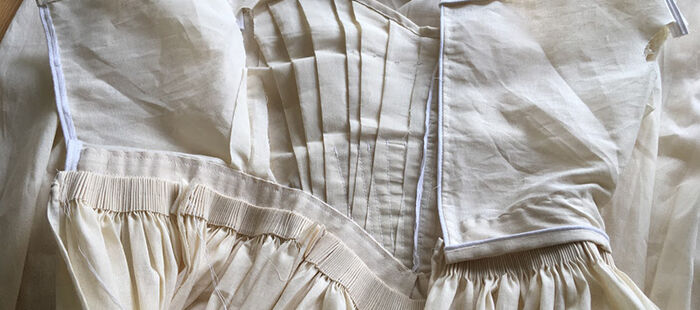 We’re now about two weeks’ away from the exhibition date and Sumeya and I have almost completed the final piece! We just have the final touches to do, like sewing on the hooks and eyes, but hope to have it completely finished a week before the event.
We’re now about two weeks’ away from the exhibition date and Sumeya and I have almost completed the final piece! We just have the final touches to do, like sewing on the hooks and eyes, but hope to have it completely finished a week before the event.
It’s one thing to see it in a toile but another in the final fabric! It will feel really great to see it displayed in the exhibition – I’ll definitely be bringing my family to see it! Plus, I’m hoping to get feedback from the experts that will be attending the conference to see what they think of our reproduction.
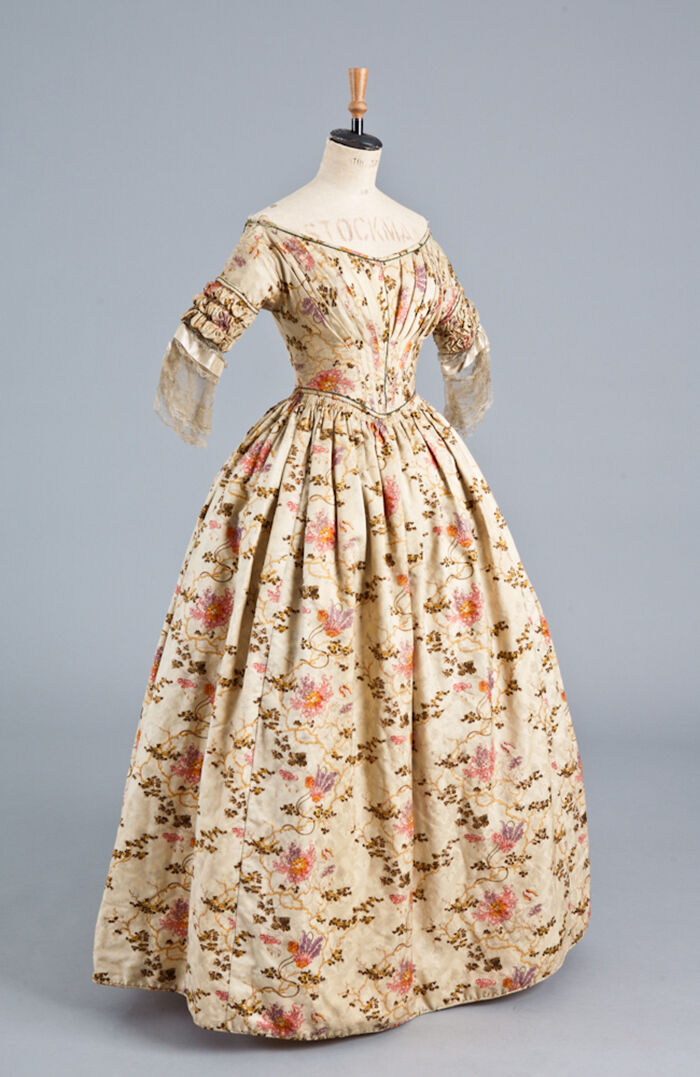 Overall I’ve really enjoyed working on reproducing the Honeysuckle dress and so glad I volunteered. It’s definitely been a commitment and challenging in parts, but I’ve learned so much! Not only have I gained extra skills and knowledge of historical dress, but I’ve really improved my pattern cutting. Before I came to University, I’d never really done any pattern cutting and before this project I had certainly never drafted a pattern from measurements alone. The experience has definitely increased my confidence, I feel much more comfortable with pattern cutting now.
Overall I’ve really enjoyed working on reproducing the Honeysuckle dress and so glad I volunteered. It’s definitely been a commitment and challenging in parts, but I’ve learned so much! Not only have I gained extra skills and knowledge of historical dress, but I’ve really improved my pattern cutting. Before I came to University, I’d never really done any pattern cutting and before this project I had certainly never drafted a pattern from measurements alone. The experience has definitely increased my confidence, I feel much more comfortable with pattern cutting now.
I also feel like the project adds a bit of colour to my CV. It’s a definite talking point when you’ve had the opportunity to work on something that’s in an archive – and to actually recreate it rather than just study it!
We also really enjoyed being able to work with other students within our wider Faculty of Arts, Design and Media. Students from the School of Visual Communications are making the exhibition space for ‘Cabinets of Costume’ and have also made the mannequins for our five dresses because back then they were made for such narrow waists that they would be too small for our industry-standard mannequins. The great thing about having them made specifically for our reproductions is that the Visual Communications students were able to create them in keeping with the historic theme so the final exhibition is going to look incredible! Watch this space…




